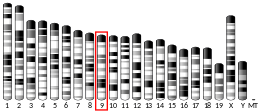CCRL1
C-C chemokine receptor type 11 is a protein that in humans is encoded by the CCRL1 gene.[5][6]
The protein encoded by this gene is a member of the G protein-coupled receptor family, and is a receptor for C-C type chemokines. This receptor has been shown to bind dendritic cell- and T cell-activated chemokines including CCL19/ELC, CCL21/SLC, and CCL25/TECK. Alternatively spliced transcript variants encoding the same protein have been described.[6]
References
- GRCh38: Ensembl release 89: ENSG00000129048 - Ensembl, May 2017
- GRCm38: Ensembl release 89: ENSMUSG00000079355 - Ensembl, May 2017
- "Human PubMed Reference:". National Center for Biotechnology Information, U.S. National Library of Medicine.
- "Mouse PubMed Reference:". National Center for Biotechnology Information, U.S. National Library of Medicine.
- Khoja H, Wang G, Ng CT, Tucker J, Brown T, Shyamala V (May 2000). "Cloning of CCRL1, an orphan seven transmembrane receptor related to chemokine receptors, expressed abundantly in the heart". Gene. 246 (1–2): 229–38. doi:10.1016/S0378-1119(00)00076-7. PMID 10767544.
- "Entrez Gene: CCRL1 chemokine (C-C motif) receptor-like 1".
Further reading
- Maruyama K, Sugano S (1994). "Oligo-capping: a simple method to replace the cap structure of eukaryotic mRNAs with oligoribonucleotides". Gene. 138 (1–2): 171–4. doi:10.1016/0378-1119(94)90802-8. PMID 8125298.
- Suzuki Y, Yoshitomo-Nakagawa K, Maruyama K, et al. (1997). "Construction and characterization of a full length-enriched and a 5'-end-enriched cDNA library". Gene. 200 (1–2): 149–56. doi:10.1016/S0378-1119(97)00411-3. PMID 9373149.
- Bacon KB, Schall TJ, Dairaghi DJ (1998). "RANTES activation of phospholipase D in Jurkat T cells: requirement of GTP-binding proteins ARF and RhoA". J. Immunol. 160 (4): 1894–900. PMID 9469451.
- Gosling J, Dairaghi DJ, Wang Y, et al. (2000). "Cutting edge: identification of a novel chemokine receptor that binds dendritic cell- and T cell-active chemokines including ELC, SLC, and TECK". J. Immunol. 164 (6): 2851–6. doi:10.4049/jimmunol.164.6.2851. PMID 10706668.
- Schweickart VL, Epp A, Raport CJ, Gray PW (2000). "CCR11 is a functional receptor for the monocyte chemoattractant protein family of chemokines". J. Biol. Chem. 275 (13): 9550–6. doi:10.1074/jbc.275.13.9550. PMID 10734104.
- Schweickart VL, Epp A, Raport CJ, Gray PW (2001). "CCR11 is a functional receptor for the monocyte chemoaattractant protein family of chemokines". The Journal of Biological Chemistry. 276 (1): 856. PMID 11134065.
- Townson JR, Nibbs RJ (2002). "Characterization of mouse CCX-CKR, a receptor for the lymphocyte-attracting chemokines TECK/mCCL25, SLC/mCCL21 and MIP-3beta/mCCL19: comparison to human CCX-CKR". Eur. J. Immunol. 32 (5): 1230–41. doi:10.1002/1521-4141(200205)32:5<1230::AID-IMMU1230>3.0.CO;2-L. PMID 11981810.
- Strausberg RL, Feingold EA, Grouse LH, et al. (2003). "Generation and initial analysis of more than 15,000 full-length human and mouse cDNA sequences". Proc. Natl. Acad. Sci. U.S.A. 99 (26): 16899–903. doi:10.1073/pnas.242603899. PMC 139241. PMID 12477932.
- Gerhard DS, Wagner L, Feingold EA, et al. (2004). "The Status, Quality, and Expansion of the NIH Full-Length cDNA Project: The Mammalian Gene Collection (MGC)". Genome Res. 14 (10B): 2121–7. doi:10.1101/gr.2596504. PMC 528928. PMID 15489334.
- Comerford I, Milasta S, Morrow V, et al. (2006). "The chemokine receptor CCX-CKR mediates effective scavenging of CCL19 in vitro". Eur. J. Immunol. 36 (7): 1904–16. doi:10.1002/eji.200535716. PMID 16791897.
External links
- Human ACKR4 genome location and ACKR4 gene details page in the UCSC Genome Browser.
- Human CCR10 genome location and CCR10 gene details page in the UCSC Genome Browser.
This article incorporates text from the United States National Library of Medicine, which is in the public domain.
This article is issued from Wikipedia. The text is licensed under Creative Commons - Attribution - Sharealike. Additional terms may apply for the media files.



